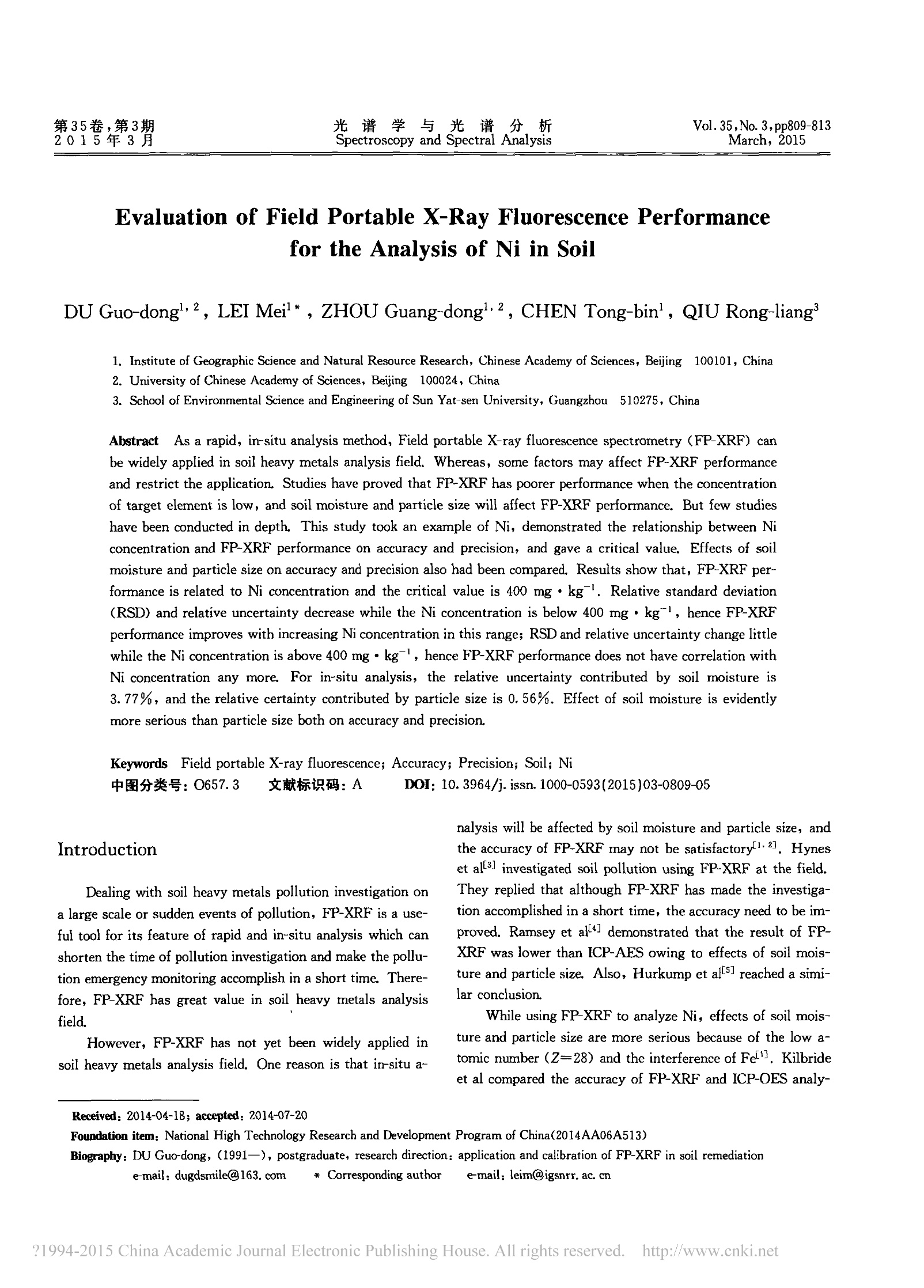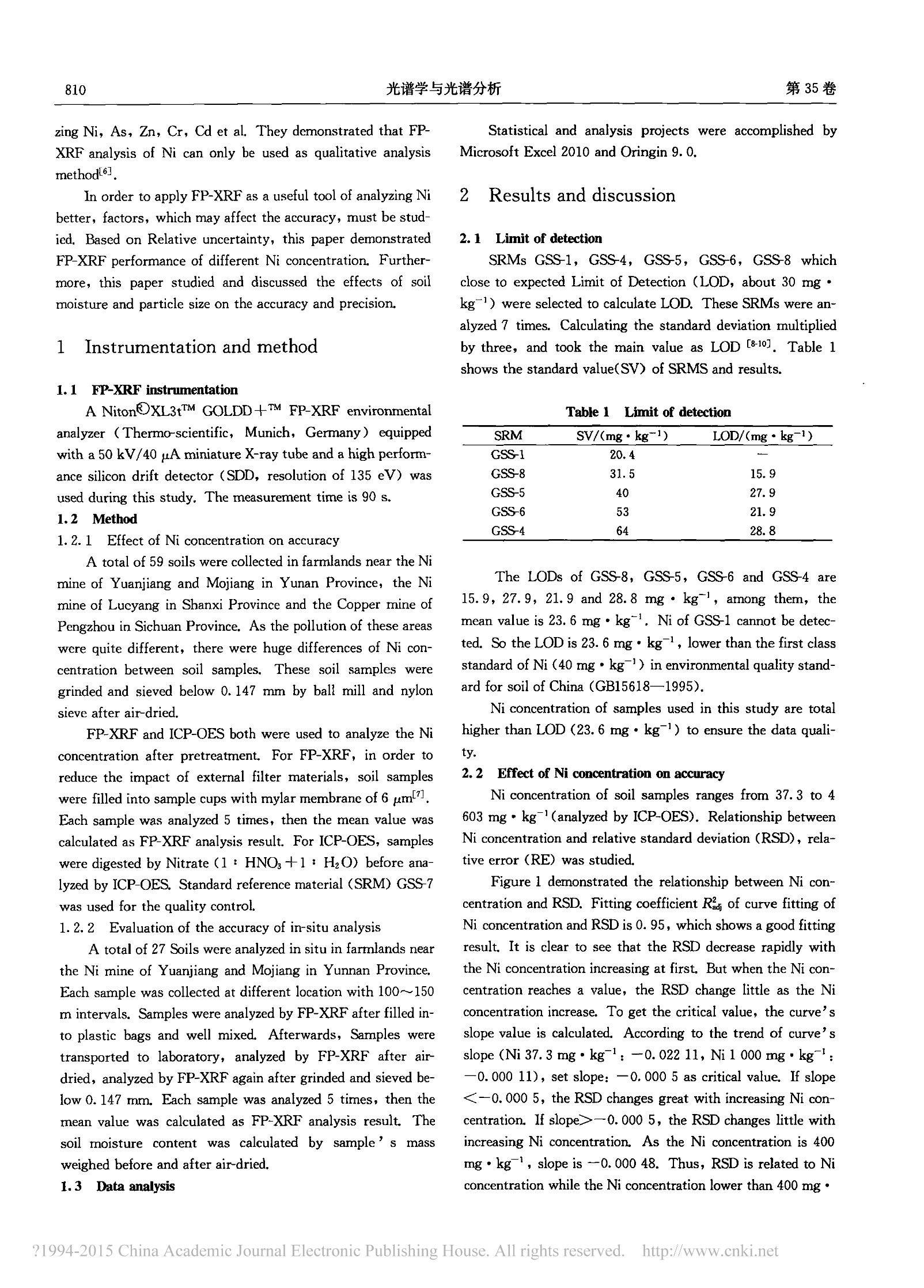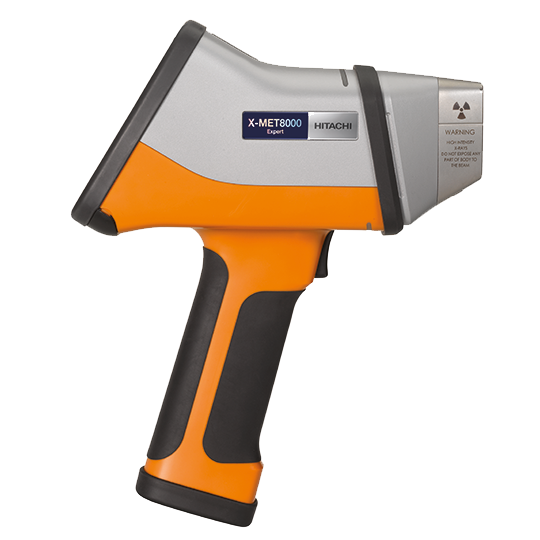方案详情文
智能文字提取功能测试中
光谱 学 与光谱 分析Spectroscopy and Spectral Analysis第35卷,第3期2015年3月Vol.35,No.3,pp809-813March, 2015 光谱学与光谱分析第35卷810 Evaluation of Field Portable X-Ray Fluorescence Performancefor the Analysis of Ni in Soil DU Guo-dong'2, LEI Mei*, ZHOU Guang-dong'2, CHEN Tong-bin', QIU Rong-liang’ 1. Institute of Geographic Science and Natural Resource Research, Chinese Academy of Sciences, Beijing 100101, China 2. University of Chinese Academy of Sciences, Beijing1100024,China 3. School of Environmental Science and Engineering of Sun Yat-sen University, Guangzhou 510275, China Abstract As a rapid, in-situ analysis method, Field portable X-ray fluorescence spectrometry (FP-XRF) canbe widely applied in soil heavy metals analysis field. Whereas, some factors may affect FP-XRF performanceand restrict the application. Studies have proved that FP-XRF has poorer performance when the concentrationof target element is low, and soil moisture and particle size will affect FP-XRF performance. But few studieshave been conducted in depth. This study took an example of Ni, demonstrated the relationship between Niconcentration and FP-XRF performance on accuracy and precision, and gave a critical value. Effects of soilmoisture and particle size on accuracy and precision also had been compared. Results show that, FP-XRF per-formance is related to Ni concentration and the critical value is 400 mg· kg. Relative standard deviation(RSD) and relative uncertainty decrease while the Ni concentration is below 400 mg· kg, hence FP-XRFperformance improves with increasing Ni concentration in this range; RSD and relative uncertainty change littlewhile the Ni concentration is above 400 mg· kg, hence FP-XRF performance does not have correlation withNi concentration any more. For in-situ analysis, the relative uncertainty contributed by soil moisture is3.77%, and the relative certainty contributed by particle size is 0.56%. Effect of soil moisture is evidentlymore serious than particle size both on accuracy and precision. KeywordsSField portable X-ray fluorescence; Accuracy; Precision; Soil; Ni 中图分类号:O657.3 文献标识码: A DOI: 10.3964/j. issn.1000-0593(2015)03-0809-05 Introduction Dealing with soil heavy metals pollution investigation ona large scale or sudden events of pollution, FP-XRF is a use-ful tool for its feature of rapid and in-situ analysis which canshorten the time of pollution investigation and make the pollu-tion emergency monitoring accomplish in a short time. There-fore, FP-XRF has great value in soil heavy metals analysisfield. However, FP-XRF has not yet been widely applied insoil heavy metals analysis field. One reason is that in-situ a- nalysis will be affected by soil moisture and particle size, andthe accuracy of FP-XRF may not be satisfactory1.2]. Hyneset al3 investigated soil pollution using FP-XRF at the field.They replied that although FP-XRF has made the investiga-tion accomplished in a short time, the accuracy need to be im-proved. Ramsey et all4 demonstrated that the result of FP-XRF was lower than ICP-AES owing to effects of soil mois-ture and particle size. Also, Hurkump et al5] reached a simi-lar conclusion. While using FP-XRF to analyze Ni, effects of soil mois-ture and particle size are more serious because of the low a-tomic number (Z=28) and the interference of Fel. Kilbrideet al compared the accuracy of FP-XRF and ICP-OES analy- ( Received: 2 014-04-18; a ccepted: 2014-07-20 ) ( Foundation item: National High Technology Research and Development Program of China(2014AA06A513) ) ( Biography: D U Guo-dong, (1991一), postgraduate, research direction: application and calibration of FP-XRF in soi l re m ediation ) e-mail: dugdsmile@163. com * Corresponding author e-mail: leim@igsnrr. ac. cn zing Ni, As, Zn, Cr, Cd et al. They demonstrated that FP-XRF analysis of Ni can only be used as qualitative analysismethod61 In order to apply FP-XRF as a useful tool of analyzing Nibetter, factors, which may affect the accuracy, must be stud-ied. Based on Relative uncertainty, this paper demonstratedFP-XRF performance of different Ni concentration. Further-more, this paper studied and discussed the effects of soilmoisture and particle size on the accuracy and precision, Instrumentation and method 1.1 FP-XRF instrumentation A NitonOXL3tTM GOLDD+TM FP-XRF environmentalanalyzer (Thermo-scientific, Munich, Germany) equippedwith a50 kV/40 uA miniature X-ray tube and a high perform-ance silicon drift detector (SDD, resolution of 135 eV) wasused during this study. The measurement time is 90 s. 1.2 Method 1.2.1 Effect of Ni concentration on accuracy A total of 59 soils were collected in farmlands near the Nimine of Yuanjiang and Mojiang in Yunan Province, the Nimine of Lueyang in Shanxi Province and the Copper mine ofPengzhou in Sichuan Province. As the pollution of these areaswere quite different, there were huge differences of Ni con-centration between soil samples..These soil samples weregrinded and sieved below 0.147 mm by ball mill and nylonsieve after air-dried. FP-XRF and ICP-OES both were used to analyze the Niconcentration after pretreatment. For FP-XRF, in order toreduce the impact of external filter materials, soil sampleswere filled into sample cups with mylar membrane of6 um.Each sample was analyzed 5 times, then the mean value wascalculated as FP-XRF analysis result. For ICP-OES, sampleswere digested by Nitrate (1: HNO:+1: HO) before ana-lyzed by ICP-OES. Standard reference material (SRM) GSS-7. was used for the quality control. 1.2.2 Evaluation of the accuracy of in-situ analysis A total of 27 Soils were analyzed in situ in farmlands nearthe Ni mine of Yuanjiang and Mojiang in Yunnan Province.Each sample was collected at different location with 100~150m intervals. Samples were analyzed by FP-XRF after filled in-to plastic bags and well mixed. Afterwards, Samples weretransported to laboratory, analyzed by FP-XRF after air-dried, analyzed by FP-XRF again after grinded and sieved be-low 0.147 mm. Each sample was analyzed 5 times, then themean value was calculated as FP-XRF analysis result. Thesoil moisture content was calculated by sample’s massweighed before and after air-dried 1.3 Data analysis Statistical and analysis projects were accomplished byMicrosoft Excel 2010 and Oringin 9.0. 2Results and discussion 2.1 Limit of detection SRMs GSS-1, GSS-4, GSS-5, GSS-6, GSS-8 whichclose to expected Limit of Detection (LOD, about 30 mg "kg) were selected to calculate LOD. These SRMs were an-alyzed 7 times. Calculating the standard deviation multipliedby three, and took the main value as LOD [8-10]. Table 1shows the standard value(SV) of SRMS and results, Table 1 Limit of detection SRM SV/(mg·kg~) LOD/(mg·kg) GSS-1 20.4 GSS-8 31.5 15.9 GSS-5 40 27.9 GSS-6 53 21.9 GSS-4 64 28.8 The LODs of GSS-8, GSS-5, GSS-6 and GSS-4 are15.9, 27.9, 21.9 and 28.8 mg·kg, among them, themean value is 23.6 mg·kg. Ni of GSS-1 cannot be detec-ted. So the LOD is 23. 6 mg·kg, lower than the first classstandard of Ni (40 mg · kg-) in environmental quality stand-ard for soil of China (GB15618—1995). Ni concentration of samples used in this study are totalhigher than LOD (23.6 mg·kg) to ensure the data quali-ty. 2.2 Effect of Ni concentration on accuracy Ni concentration of soil samples ranges from 37.3 to 4603 mg·kg(analyzed by ICP-OES). Relationship betweenNi concentration and relative standard deviation (RSD), rela-tive error (RE) was studied. Figure 1 demonstrated the relationship between Ni con-centration and RSD. Fitting coefficient Rad of curve fitting ofNi concentration and RSD is 0.95, which shows a good fittingresult. It is clear to see that the RSD decrease rapidly withthe Ni concentration increasing at first. But when the Ni con-centration reaches a value, the RSD change little as the Niconcentration increase. To get the critical value, the curve’sslope value is calculated. According to the trend of curve'sslope (Ni 37.3 mg·kg: -0.022 11, Ni 1 000 mg·kg:-0.000 11), set slope: -0.000 5 as critical value. If slope<-0.000 5, the RSD changes great with increasing Ni con-centration. If slope>-0.000 5, the RSD changes little withincreasing Ni concentration. As the Ni concentration is 400mg·kg, slope is-0.000 48. Thus, RSD is related to Niconcentration while the Ni concentration lower than 400 mg· kg; RSD does not have correlation with Ni concentrationwhile the Ni concentration higher than 400 mg·kg. Fig.1 Relationship between Ni concentrationand RSD of FPXRF XRF technology verification report published by Environ-mental protection agency (EPA) divide Ni concentration insoil into three groups: group 1 (50~250 mg·kg), group2(250~1000 mg·kg), group 3 (>1 000 mg·kg)8.As the third class standard of Ni in environmental qualitystandard for soil of China is 200 mg·kg, according to Niconcentration, this study divided samples into three groups:group 1(20~200 mg·kg), group 2 (200~1 000 mg ·kg), group 3 (>1000 mg·kg). Figure2 shows thedifference between FP-XRF and ICP-OES of three groups.The fitting coefficients of group 1, group 2 and group 3 are0.85, 0.92, 0.98, and slopes are 1.26,0.91,0.98. Theseresults show that FP-XRF is more and more close to ICP-OESwith increasing Ni concentration.. That is, accuracy of FP-XRF improves with increasing Ni concentration. Fig. 2 Linearity relationship between ICP-OES and FPXRF of different concentration Samples were meticulously divided into 7 groups to fur-ther discuss the relationship between FP-XRF performanceand Ni concentration. According to environmental qualitystandard for soil of China (the second class standard: 60mg·kg, the third class standard: 200 mg·kg) and theprinciple of divided tightly while Ni concentration is low anddivided sparsely while Ni concentration is high, 7 groups are:group 1(0~60 mg·kg), group 2 (60~200 mg· kg),group 3 (200~400 mg·kg), group 4(400~800 mg·kg), group 5 (810~1 500 mg· kg), group 6 (1 500~3000 mg· kg), group 7 (3 000~5000 mg·kg). Rela-tive Uncertainty is the RSD of RE of each group11,12]. Figure3 shows the relative uncertainty of group 1~7. Fig.3 Uncertainty of different concentrationgroup measured by FPXRF The relative uncertainty! U of group 1 (30~60 mgkg), group 2 (60~200 mg·kg) and group 3 (200~400mg·kg) are quite different and decrease with increasing Niconcentration. After group 4(400~800mg·kg), the rel-ative uncertainty changes little. These results indicate that Udecrease with increasing Ni concentration, hence FP-XRFperformance improve with increasing Ni concentration, whenNi concentration is below 400 mg·kg. FP-XRF perform-ance does not have correlation with Ni concentration any morewhile Ni concentration is above 400 mg·kg. 2.3 Evaluation of the accuracy of in-situ analysis Compared with laboratory analysis, in-situ analysis per-formance is poorer because of effects of soil moisture and par-ticle size [13,14]. Yet few studies have compared these two fac-tors’effects on accuracy and precision. Figure 4 shows the RE of in situ analysis, air-dried soilsand sieved soil. First, air-dry process removed the influenceof soil moisture, and then grinding and sieving process re-moved the influence of particle size. For in-situ analysis,compared with the following result, most RE value is nega-tive. The size of bubble indicates the value of soil moisture,range from 1.3% to 25.7%. The RE of samples with highersoil moisture are lower than those with lower soil moisture,the RE value of the former is between -20% and -10% andthe latter is between ±10%. These results indicate that soil Fig. 4 Ni concentration measured by FPXRF moisture will make measured value low than true value. This study used relative uncertainty to compare effects ofsoil moisture and particle size on accuracy and precision. Ig-noring effects of FP-XRF instrumentation, relative uncertain-ty Utotal is composed of relative uncertainty Upree contributed byprecision and relative uncertainty Uias contributed by accura-cy. Based on this relationship, effects of soil moisture andparticle size on accuracy and precision can be separated andcompared. Their relationship can be explained by the follow-ing formula. Table 2 shows the value of Utotal, Uprec and U bias, Compa-ring Utota of in-situ analysis and air-dried samples, the formeris 12.49%, while the latter is 8.72%. This is because soilmoisture has been removed. Thus, effect of soil moisture is3.77%(3.77%=12.49%-8.72%). Utotal of sieved samplesis 8.16%, so effect of particle size is 0.56%. ComparingUpree and Utias, effects of soil moisture and particle size on pre-cision are 2.08% and 0.42%; effects of soil moisture andparticle size on accuracy are 3.29% and 0.48%. Thus, theconclusion is that effect of soil moisture is evidently more seri-ous than particle size both on accuracy and precision. Besides, the value of Ubias is obviously higher than Upree,This result indicates that the accuracy performance of FP-XRF is poorer than the precision performance. As mentioned above, the RSD value is about 2% as Ni concentration is a-bove 400 mg·kg. The precision performance of FP-XRF isgood enough. Analyzing in situ, users should pay more attention to soilmoisture rather than particle size. The accuracy performanceof FP-XRF is a problem, and calibration method should beused. Table2 Uncertainty of FP-XRF Treatment Urotal/% Upre/% Ubias/% In-situ 12. 49 4.38 11.70 Air-dried 8.72 2.30 8.41 Grinded and sieved 8.16 1.88 7.94 3 Conclusion (1) FP-XRF performance is related to Ni concentrationin samples. The critical value is 400 mg·kg. If Ni concen-tration is higher than 400 mg·kg, FP-XRF performancedoes not have correlation with Ni concentration. As the thirdclass standard of environmental quality standard for soil ofChina is 200 mg·kg,FP-XRF performance in this range ispoorer. This may cause some trouble when using FP-XRF an-alyzes uncontaminated soil. (2) Soil moisture and particle size will affect performanceof in-situ analysis. The effect of soil moisture is evidentlymore serious than the effect of particle size both on accuracyand precision. Soil moisture, which is the main influencingfactor of accuracy, will make the measured value low thantrue value. Calibration method for soil moisture is needed. ( C1 ] ]K Kalnicky DJ, Singhvi R. J . H azard. Mater., 2 0 01, 83(1):93. ) ( [2] Wu C M, Tsai H T, Yang K H, et a l. En v iron. Forensic, 2 0 12, 1 3 (2): 1 1 0. ) ( ] Patricia Hynes R M, Paul Carroll . J . Urban Health, 2001, 78(1): 1 99. ) ( [4] Ramsey M, Potts P. Analyst, 1997, 122(8): 743. ) ( [5] Hurkamp K, Raab T, Vo l kel J. Geomorphology, 2009, 110(1): 28. ) ( [6] K K ilbride C, Poole J, Hutchings T. E nviron. P ollut. , 2006, 1 4 3(1):16. ) [7]1Parsons C, Margui Grabulosa E, Pili E, et al. J. Hazard. Mater., 2013, 262:1213.[8]1Billets S. Washington,DC, 2006.15. ( [9] Bernick M, Kalnicky D, Prince G, et al. Journal of Hazardous Materials, 1995, 43(1):1 0 1. ) ( [10] Weindorf D C, Zhu Y, Ferrell R, e t al. Soil Science, 2009,174(10): 5 5 6. ) ( [11]Wang W Y, Zhan X M, Yua n J H, et al. Spectrosc. Sp e ct. A n al., 2011, 31 ( 6):170 7 . ) ( [12] Ramsey M H, Ar g yraki A. Sci. Total Environ., 1 9 97, 198 ( 3): 243. ) ( [13]Ge L, Lai W, Lin Y. X-Ray Spectrom., 2005, 3 4(1): 28. ) ( [14] Kohlbach J M. R o chester In s titute of Technology, 20 0 9. ) 便携式X射线荧光仪测定土壤中镍的精度研究 杜国栋12,雷 梅*,周广东12,陈同斌1,仇荣亮3 1.中国科学院地理科学与资源研究所,北京 100101 2.中国科学院大学,北京 100024 3.中山大学环境科学与工程学院,广东广州 510275 摘 要 作为一种快速、现场检测的分析方法,便携式X射线荧光光谱(FP-XRF)可以在土壤重金属分析领域获得广泛应用。然然, FP-XRF的测定精度受到一些因素的影响,制约了它的应用。前人的研究已经发现,当元素含量较低时, FP-XRF 的测定精度不佳。在现场检测时也会受到土壤湿度效应和粒径的影响。但是尚未有研究对上述因素的影响类型和影响程度进行深入探究。本文以 Ni 为例,根据准确度和精密度,研究了Ni 含量与 FP-XRF测定精度的关系,得出了这种影响的临界值;比较了现场测定中土壤湿度效应和粒径对准确度和精密度的影响程度。实验表明, FP-XRF的测定精度与 Ni含量相关,临界值为400 mg·kg. Ni的浓度低低400 mg·kg时,相对标准偏差(RSD)和相对不确定度同时降低,即测定精度随着 Ni 含量的升高而提高; Ni的浓度高于于400mg·kg时相对标准偏差(RSD)和相对不确定度不再有明显变化,即测定精度不再与 Ni 含量有关。现场检测中,土壤水分贡献的相对不确定度为3.77%,粒径贡献的相对不确定度为0.56%。土壤湿度效应对准确度和精密度的影响程度都要高于土壤粒径。 关键词 便携式X射线荧光仪;精度;土壤; 镍 ( (收稿日期:2014-04-18,修订日期:2014-07-20) ) *通讯联系人 ?China Academic Journal Electronic Publishing House. All rights reserved. http://www.cnki.net 作为一种快速、现场检测的分析方法,便携式X射线荧光光谱(FP-XRF)可以在土壤重金属分析领域获得广泛应用。然而,FP-XRF的测定精度受到一些因素的影响,制约了它的应用。前人的研究已经发现,当元素含量较低时,FP-XRF的测定精度不佳。在现场检测时也会受到土壤湿度效应和粒径的影响。但是尚未有研究对上述因素的影响类型和影响程度进行深入探究。 本文以Ni为例,根据准确度和精密度,研究了Ni含量与FP-XRF测定精度的关系,得出了这种影响的临界值;比较了现场测定中土壤湿度效应和粒径对准确度和精密度的影响程度。实验表明,FP-XRF的测定精度与Ni含量相关,临界值为400 mg·kg~(-1)。Ni的浓度低于400 mg·kg~(-1)时,相对标准偏差(RSD)和相对不确定度同时降低,即测定精度随着Ni含量的升高而提高;Ni的浓度高于于400 mg·kg~(-1)时相对标准偏差(RSD)和相对不确定度不再有明显变化,即测定精度不再与Ni含量有关。现场检测中,土壤水分贡献的相对不确定度为3.77%,粒径贡献的相对不确定度为0.56%。土壤湿度效应对准确度和精密度的影响程度都要高于土壤粒径。
关闭-
1/5

-
2/5

还剩3页未读,是否继续阅读?
继续免费阅读全文产品配置单
上海怡星机电设备有限公司为您提供《土壤中镍检测方案(能散型XRF)》,该方案主要用于土壤中(类)金属及其化合物检测,参考标准《暂无》,《土壤中镍检测方案(能散型XRF)》用到的仪器有赛默飞尼通便携式XRF元素分析仪 XL3t 700s。
我要纠错
推荐专场
X荧光光谱、XRF(能量色散型X荧光光谱仪)
更多相关方案






 咨询
咨询




